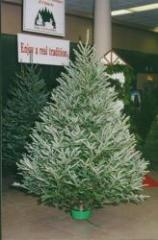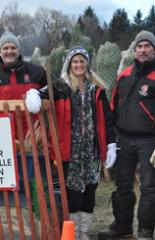
The Environmental Choice - Real Christmas Trees



Long before the advent of Christianity, plants and trees that remained green all year had a special meaning for people in the winter. Just as people today decorate their homes during the festive season with pine, spruce and fir trees, ancient peoples hung evergreen boughs over their doors and windows. In many countries people believed that evergreens would keep away witches, ghosts, evil spirits and illness.
In the Northern hemisphere, the shortest day and longest night of the year falls on December 21 or December 22 and is called the winter solstice. Many ancient peoples believed that the sun was a god and that winter came every year because the sun god had become sick and weak. They celebrated the solstice because it meant that at last the sun god would begin to get well. Evergreen boughs reminded them of all the green plants that would grow again when the sun god was strong and summer would return.
The ancient Egyptians worshipped a god called Ra, who had the head of a hawk and who wore the sun as a blazing disc in his crown. At the solstice, when Ra began to recover from the illness, the Egyptians filled their homes with green palm rushes which symbolized for them the triumph of life over death.
Across the Mediterranean Sea, the early Romans marked the solstice with a feast called the Saturnalia in honour of Saturn, the god of agriculture. The Romans knew that the solstice meant that soon farms and orchards would be green and fruitful. To mark the occasion, they decorated their homes and temples with evergreen boughs. The Saturnalia was a special time of peace and equality when wars could not be declared, when slaves and masters could eat at the same table, and when gifts were exchanged as a symbol of affection and brotherhood.
In Northern Europe the mysterious Druids, the priests of the ancient Celts, also decorated their temples with evergreen boughs as a symbol of everlasting life. The fierce Vikings in Scandanavia thought that evergreens were the special plant of the sun god, Balder. Many historians believe that our word for Yule came from the Norse word, 'rol', the Gothic word 'hiul' or the Saxon work 'hweol' all of which mean wheel and refer to the cycles of the sun.
When families bring home their Christmas tree from a sales lot or a choose-and-cut tree farm, they are following a tradition that is more than a thousand years old. "Bringing in the Yule log" was a ritual that began in Great Britain and that spread throughout Europe, eventually reaching North America. On Christmas Eve, the large central trunk of a great tree was dragged from the forest. Everyone in the family, both adults and children, helped with the job by pulling on the ropes. When the log was finally brought into the house, it was thrown on the family fireplace where it burned for the 12 days of Christmas. Many superstitions surrounded the log: it had to be ignited the first time a flame was put to it or bad luck would surely follow; it had to be lit with a stick saved from the fire from the year before or the house would burn down; and unless charcoal from the great fire was kept under the family beds for the following year, the house might be struck by lightning. As the Yule log spread through Europe it acquired many customs and many names. In Ireland, it was called "bloc na Nodleg", or Christmas block. In Spain, children followed the log as it was dragged through the village, beating it with sticks to drive out the evil spirits; they were rewarded with gifts of nuts and chocolates by people who lived along the way. In the Balkan areas of Europe, women decorated the log with red silk, gold wire, needles and flowers before it was thrown into the fire. Hardly anyone burns a Yule log anymore, but some memories of it remain. In French homes, instead of Christmas cake, children enjoy a rich chocolate roll covered with a dark brown frosting that looks just like bark. Sometimes the "buche de Noel", or Christmas log, is decorated with frosted berries and holly needles, or with marzipan mushrooms, as a reminder of the great logs that were once dragged from the forest.
 How to take good care of your Christmas Tree:More info..
How to take good care of your Christmas Tree:More info..
 Contact the CTFO office via convenient online email form, phone, fax, or mail...More info..
Contact the CTFO office via convenient online email form, phone, fax, or mail...More info..